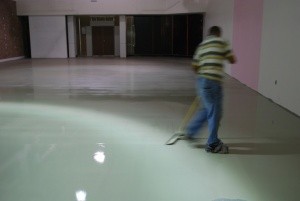 Epoxy floors are resilient, impact resistant, somewhat flexible and hard. They definitely supplement an efficient, durable and long lasting floor coating system by providing build thickness. However, in most cases, the best results come from an epoxy floor with a thin-film polyurethane (often referred to as a “urethane”) topcoat. This is because a polyurethane topcoat can enhance your floor with a number of unique properties that an epoxy floor coating cannot.
Epoxy floors are resilient, impact resistant, somewhat flexible and hard. They definitely supplement an efficient, durable and long lasting floor coating system by providing build thickness. However, in most cases, the best results come from an epoxy floor with a thin-film polyurethane (often referred to as a “urethane”) topcoat. This is because a polyurethane topcoat can enhance your floor with a number of unique properties that an epoxy floor coating cannot.
When an Epoxy Floor Coating is Not Enough
Many home improvement stores sell DIY epoxy garage floor kits. These kits often consist of relatively inexpensive, low solids, water-based epoxies. It is not surprising to encounter user reviews of these products commenting on how easily they chip, pick up hot tire marks, scratch, easily stain and turn yellow over time. While these DIY products usually make functional primers and basecoats, they simply cannot achieve the finish coat properties of a top-quality, non-yellowing polyurethane. An epoxy coating, in this case, is just not good enough to meet the home owner’s expectations. The absence of a high-performance urethane topcoat, or improper concrete preparation, is the most likely cause of a flooring system that fails prematurely.
The Right Topcoat Makes All the Difference
 A polyurethane topcoat can add chemical resistance, scratch resistance, gloss retention, yellowing resistance and easier cleanability to an “epoxy” floor coating system. Additionally, fine aggregate additives made from silica sand, aluminum oxide, or even spherical glass bead can be stirred into the urethane topcoat to add significant slip and wear-resistance while maintaining easy cleanability. These additives also break up the gloss on the floor which hides, or camouflages, unavoidable bits of dirt, roller lint and settled airborne particles. These also hide minor imperfections in the concrete substrate, especially if a satin finish urethane is used.
A polyurethane topcoat can add chemical resistance, scratch resistance, gloss retention, yellowing resistance and easier cleanability to an “epoxy” floor coating system. Additionally, fine aggregate additives made from silica sand, aluminum oxide, or even spherical glass bead can be stirred into the urethane topcoat to add significant slip and wear-resistance while maintaining easy cleanability. These additives also break up the gloss on the floor which hides, or camouflages, unavoidable bits of dirt, roller lint and settled airborne particles. These also hide minor imperfections in the concrete substrate, especially if a satin finish urethane is used.
Of course, when it comes to polymer floor coatings, unique needs and circumstances dictate the best grouping of primers, basecoats and topcoats to use to achieve the desired results. There is an extensive list of polymer flooring choices, such as vinyl esters, novalac epoxies, urethane concrete, ESD coatings, epoxy or polyurethane mortars, and more to accommodate any situation. These are typically used in industrial areas with very specific requirements and not found in DIY home improvement stores.
What are your specific flooring requirements? Take our online Flooring Self-Assessment. You might be surprised at what you uncover about your floors.
- Aesthetics: The Art and Science of Decorative Flooring - August 28, 2025
- Why Epoxy Mortar Outperforms Traditional Concrete in Industrial Applications - August 27, 2025
- How Antimicrobial Flooring Supports Health and Safety in Critical Environments - August 22, 2025


